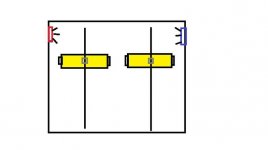Just planning how I'm going to set up a room when I get to CO next month and I was wondering how you guys would suggest running the ducting for 2x 1000w cool hoods on movers where it doesn't bunch up or catch. The dimensions of the room will probably be about 8x8x8. Set up kind of like this unless someone has a better suggestion for the lights and movers. Thanks guys! The blue is cool air intake and the red is obviously hot exhaust

-
As of today ICMag has his own Discord server. In this Discord server you can chat, talk with eachother, listen to music, share stories and pictures...and much more. Join now and let's grow together! Join ICMag Discord here! More details in this thread here: here.
You are using an out of date browser. It may not display this or other websites correctly.
You should upgrade or use an alternative browser.
You should upgrade or use an alternative browser.
Help with venting cool hoods on movers please?
- Thread starter OGeazy
- Start date
xMetatronx
Member
You really need to make sure you have the extra cord and ducting obviously, but every setup is different, depends on the hoods etc. but remember you are going to lose headroom so mount that baby as high in the room as possible. And google pictures of light movers.
I am currently running (2) 1k hoods on just 1 mover. I'll try to snap a pic for you tonite. I don't hang from the motor instead I am push/pull using a threaded rod. I had to but another rail and extra trolleys. Pics will be key to the idea I engineered.Just planning how I'm going to set up a room when I get to CO next month and I was wondering how you guys would suggest running the ducting for 2x 1000w cool hoods on movers where it doesn't bunch up or catch. The dimensions of the room will probably be about 8x8x8. Set up kind of like this unless someone has a better suggestion for the lights and movers. Thanks guys! The blue is cool air intake and the red is obviously hot exhaust
https://www.icmag.com/ic/attachment.php?attachmentid=314194View Image
Done that too with my previous room that was long and narrow. Revamped last fall to a more square room. Getting better results and with wider room easier to manage. For 2 on same rail I put the mover motor in the middle and push/pull both with same threaded rod. Going to find my camera...Looks like your tryin to make 2 lights do the work of 4?
Light movers only move the lights 8-12 inches when setup properly.
I put both those lights on one side move em bout 8"s back n forth then after harvest complete the room the same way on the other side.
Shoot the camera's dead and can't find charger yet. So here's the set up.^^ that sounds like what I'll have to do
You need:
2 rails, 4 trolleys, 1 motor, (1) 4'-6' and (1) 2'-4' threaded steel dowel with a couple washers and some nuts, zip ties, light rigid tubing (conduit or copper pipe works) and all the other stuff to hang and duct.
First, there are two ways to orientate the hoods, 1) they move such that the duct ends are facing the direction of movement. 2) they are perpendicular to the direction(s) of movement. Yours looks like perpendicular to direction(s) of movement.
Tradeoffs are that with type 2 you need a much wider room and the flex duct will have greater overall aie resistance but the benefit is that connecting duct between the hoods is straight so less resistance there. I use a rigid aluminum duct that is bendable for the connection between hood.
The motor runs on one of the rails and is position at extreme end of the rail. Each hood needs two trolley. Put motor and trolleys on rail and position them according to desired distances from motor as well as the apprx. distance for the hood hooks. Slide the dowel through the trolleys and through the motor fasten washers and nuts to lock in place. For non-motor side use the smaller dowel and lock the trolley distance in place.
Then use the tubing to connect the motored side the non. I ran a tube from each trolly to the adjacent and secure with zip ties such that the tubes were parallel to each other and perpendicular to the rail. Then I took a tube and ran it from the dowel area just in front of motor and ran on diag. to the far trolley on non motor side. Then I ran a tube on a diag. from farthermost trolley on motor side to trolley on non motor side.
For the ducting (if its perpendicular to direction(s) of movement) find the mid point of the movement and then the point about 2 times the distance that the motor moves. This is your pivot point. The closer to the duct end of hood that this pivot is, the greater the sag needed for your duct, which decreases efficiency.
If you are not running this orientation a bit diff method is employed.
At the pivot point put a hook or something in the ceiling and strap the ducting so you have enough sag. The duct at the pivot should be at least as high as the duct end of hood. if the run from the pivot to intake or exhaust is at a 90 deg. you may want to use an elbow. The elbow should be centered at the pivot point.



